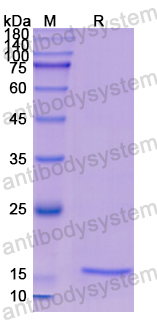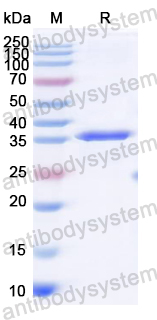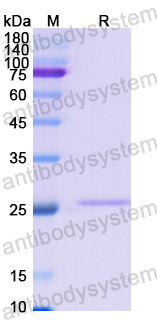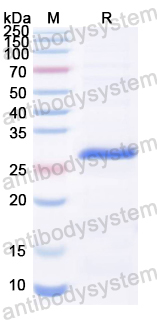Catalog No.
YHC39401
Expression system
E. coli
Species
Homo sapiens (Human)
Protein length
Trp21-Ala141
Predicted molecular weight
16.66 kDa
Nature
Recombinant
Endotoxin level
Please contact with the lab for this information.
Purity
>90% as determined by SDS-PAGE.
Accession
P09228
Applications
ELISA, Immunogen, SDS-PAGE, WB, Bioactivity testing in progress
Form
Lyophilized
Storage buffer
Lyophilized from a solution in PBS pH 7.4, 0.02% NLS, 1mM EDTA, 4% Trehalose, 1% Mannitol.
Reconstitution
Reconstitute in sterile water for a stock solution. A copy of datasheet will be provided with the products, please refer to it for details.
Shipping
In general, proteins are provided as lyophilized powder/frozen liquid. They are shipped out with dry ice/blue ice unless customers require otherwise.
Stability and Storage
Use a manual defrost freezer and avoid repeated freeze thaw cycles. Store at 2 to 8°C for frequent use. Store at -20 to -80°C for twelve months from the date of receipt.
Alternative Names
Cystatin-SA, Cystatin-S5, Cystatin-2, CST2
Pan-cancer and experimental analyses reveal the immunotherapeutic significance of CST2 and its association with stomach adenocarcinoma proliferation and metastasis., PMID:39926600
Prediction of phenotypes by secretory biomarkers and machine learning in patients with chronic rhinosinusitis., PMID:39911041
CST2 promotes cell proliferation and regulates cell cycle by activating Wnt-β-catenin signalling pathway in serous ovarian cancer., PMID:38864487
Cystatin SA attenuates gastric cancer cells growth and increases sensitivity to oxaliplatin via PI3K/AKT signaling pathway., PMID:38717526
Investigating the prognostic and predictive value of the type II cystatin genes in gastric cancer., PMID:37978366
Nasal epithelial gene expression and total IgE in children and adolescents with asthma., PMID:37742934
CST2 is activated by RUNX1 and promotes pancreatic cancer progression by activating PI3K/AKT pathway., PMID:37722526
Pyroptosis, apoptosis, and necroptosis molecular subtype derived prognostic signature universal applicable for gastric cancer-A large sample and multicenter retrospective analysis., PMID:36044785
A tonoplast-localized magnesium transporter is crucial for stomatal opening in Arabidopsis under high Mg2+ conditions., PMID:35976788
Cystatin SN is a potent upstream initiator of epithelial-derived type 2 inflammation in chronic rhinosinusitis., PMID:35660375
Identification of novel key genes associated with the metastasis of prostate cancer based on bioinformatics prediction and validation., PMID:34696780
Genomic Instability of Mutation-Derived Gene Prognostic Signatures for Hepatocellular Carcinoma., PMID:34676211
Preliminary study of genome-wide association identified novel susceptibility genes for thyroid-related hormones in Chinese population., PMID:34533693
Identification of Cysteine Protease Inhibitor CST2 as a Potential Biomarker for Colorectal Cancer., PMID:34335931
Cystatin 2 leads to a worse prognosis in patients with gastric cancer., PMID:33302616
Escalation in mucus cystatin 2, pappalysin-A, and periostin levels over time predict need for recurrent surgery in chronic rhinosinusitis with nasal polyps., PMID:31430426
A four-gene transcript score to predict metastatic-lethal progression in men treated for localized prostate cancer: Development and validation studies., PMID:31376183
Discriminant analysis followed by unsupervised cluster analysis including exosomal cystatins predict presence of chronic rhinosinusitis, phenotype, and disease severity., PMID:31322841
Transcriptome profiling revealed multiple genes and ECM-receptor interaction pathways that may be associated with breast cancer., PMID:31182966
Investigation of the clinical significance and prospective molecular mechanisms of cystatin genes in patients with hepatitis B virus‑related hepatocellular carcinoma., PMID:31115549
Enrichment and Proteomic Characterization of the Cyst Wall from In Vitro Toxoplasma gondii Cysts., PMID:31040239
Pathogenetic gene changes of eutopic endometrium in patients with ovarian endometriosis., PMID:30882467
Identification of Potential Key Genes Associated With the Pathogenesis and Prognosis of Gastric Cancer Based on Integrated Bioinformatics Analysis., PMID:30065754
Functional and genomic characterisation of a xenograft model system for the study of metastasis in triple-negative breast cancer., PMID:29720474
Longitudinal autoantibody responses against tumor-associated antigens decrease in breast cancer patients according to treatment modality., PMID:29386014
Multitissue Transcriptomics Delineates the Diversity of Airway T Cell Functions in Asthma., PMID:28933920
Structural Dynamics Investigation of Human Family 1 & 2 Cystatin-Cathepsin L1 Interaction: A Comparison of Binding Modes., PMID:27764212
Target DNA recognition and cleavage by a reconstituted Type I-G CRISPR-Cas immune effector complex., PMID:27582008
Off-pump myocardial revascularization attenuates endothelin-1 expression in systemic, pulmonary, and coronary circulation., PMID:25398294
Evolution of C, D and S-type cystatins in mammals: an extensive gene duplication in primates., PMID:25329717
Hydroalcoholic seed extract of Coriandrum sativum (Coriander) alleviates lead-induced oxidative stress in different regions of rat brain., PMID:24793421
Global secretome analysis identifies novel mediators of bone metastasis., PMID:22688892
Human salivary cystatin SA exhibits antimicrobial effect against Aggregatibacter actinomycetemcomitans., PMID:22582873
A structural comparison of three isoforms of anionic trypsin from chum salmon (Oncorhynchus keta)., PMID:19564692
Relationship between antimicrobial protein levels in whole saliva and periodontitis., PMID:18251646
Extracellular production of human cystatin S and cystatin SA by Bacillus subtilis., PMID:16737825
Murine monoclonal antibody which can distinguish cystatins SA1 and SA2., PMID:15829315
Cystatin SA, a cysteine proteinase inhibitor, induces interferon-gamma expression in CD4-positive T cells., PMID:15196002
Sac I Restriction Fragment Length Polymorphism (RFLP) related to the human CST2 gene., PMID:12013824
Expression of type 2 cystatin genes CST1-CST5 in adult human tissues and the developing submandibular gland., PMID:11879580
Functional aspects of the human salivary cystatins in the oral environment., PMID:10483070
Sequence variations of the CST2 gene related to the polymorphism of salivary cystatin SA., PMID:10326727
Production and characterization of two variants of human cystatin SA encoded by two alleles at the CST2 locus of the type 2 cystatin gene family., PMID:9587407
Characterization of human sublingual-gland protein kinase by phosphorylation of a peptide related to secreted proteins., PMID:9347115
Direct mapping of seven genes encoding human type 2 cystatins to a single site located at 20p11.2., PMID:7896273
Genetic polymorphisms of the CST2 locus coding for cystatin SA., PMID:8034293
Characterization of two members (CST4 and CST5) of the cystatin gene family and molecular evolution of cystatin genes., PMID:1334620
Identification of full-sized forms of salivary (S-type) cystatins (cystatin SN, cystatin SA, cystatin S, and two phosphorylated forms of cystatin S) in human whole saliva and determination of phosphorylation sites of cystatin S., PMID:1778989
Salivary cystatin SA-III, a potential precursor of the acquired enamel pellicle, is phosphorylated at both its amino- and carboxyl-terminal regions., PMID:1898055
The human cystatin C gene (CST3) is a member of the cystatin gene family which is localized on chromosome 20., PMID:2764935





